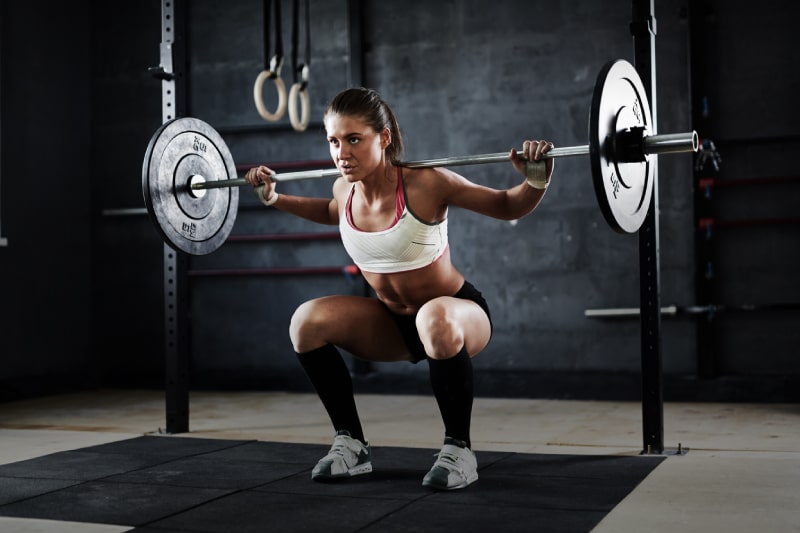What’s Better for Women: Weight Loss or Muscle Gain?

Let’s get one thing straight right off the bat, ladies: lifting weights is not going to make you bulky. Seriously. That’s a myth you can let go of right now. Unless you’re training and eating with the intention to pack on as much muscle as you can, strength training isn’t instantly going to make you look like the She Hulk. (Not that there’s anything wrong with that. She Hulk looks damn good.)
It’s easy to be intimidated by the weights section of your gym and stick to the familiarity and simplicity of the cardio machines, but if you’re looking to change the shape of your body, focusing on strictly losing weight might not be your best bet. But which type of workout should you focus on? Cardio fueled weight loss? Or heart pumping, muscle building strength training?
If you want the best results, you’re going to need some of both. Here are the ways weight loss and muscle gain can work together to give you a body that looks and feels exactly like you want it to.
The Benefits of Losing Weight

Reaching and maintaining a healthy weight can have a host of health benefits. You know all about that, though. According to the Harvard T.H. Chan School of Public Health, keeping your weight within a healthy range can help lower the risk of heart disease, stroke, diabetes and high blood pressure. It can also knock down the risk of many different types of cancer.
Inversely, packing on the pounds can put you at a higher risk for all of these troublesome, often deadly conditions: cardiovascular disease, heart attack, stroke, diabetes, cancer, arthritis, gallstones, asthma, cataracts, infertility, snoring and sleep apnea. The T.H. Chan School claims that most adults between the ages of 18 and 49 gain a pound or two of weight every year.
Since we know that the best way to lose fat is to burn calories, it can be assumed that the best way to burn calories is to do exercises that expend the most energy. A chart created by the Harvard Medical School compares the calories burned doing 30 minutes of dozens of different exercises, from gym activities to sports and the things we do every day. Which activities boasted the biggest burn? Cardio.
Running 7.5 miles at an eight-minute mile speed sloughed off 465 calories in a half hour for a person who weighs 155 pounds. Pumping away vigorously on a stationary bike burned 391, roller blading burned 260 and waltzing through your regular grocery shopping trip burned 130. General weight lifting? Well, that only burned 112 calories for a half hour of heavy lifting.
By that logic, the best way to stay on top of your weight and avoid all of the pitfalls of gaining is to plug away at cardio, burning the most calories you can, right? Not necessarily.
The Benefits of Gaining Muscle

Enter: weight training. On the surface, it might seem like doing exercises to build strength isn’t as good as cardio for helping you achieve your health, fitness and physique goals. But that can be a little misleading. When you’re aiming to achieve a new level of fitness or change your weight, strength training can be integral to achieving your goals.
It all has to do with body composition. To simplify, the more muscle you have, the more calories you’re going to burn. Therefore strength training to build muscle is going to help you shed more fat and maintain a healthy weight.
According to the Mayo Clinic, your body size and composition can alter your body’s metabolism. “The bodies of people who are larger or have more muscle burn more calories, even at rest,” the report says. The more muscle you have, the better you are at burning calories no matter what activity you’re doing.
A good strength training sweat session can give your metabolism an extra boost after your workout, too. A study from the Journal of Translational Medicine cited by Men’s Health explained the concept a little bit further. Two groups of trained lifters were studied to see the effect weight lifting had on their metabolism 22 hours after a vigorous workout at the gym.
One group performed four sets of eight exercises, resting for one or two minutes between sets of the compound exercises, lifting to failure with each set. Another group did just three exercises using a “rest-pause” technique in which they chose the heaviest weight they could lift six time for each exercise, rested for 20 seconds and then immediately jumped back in and completed as many additional reps as they could.
After 22 hours, the group that used the “rest-pause” technique had a resting metabolism that was 452 calories higher than it was before their workout. The other group saw a metabolic increase of only 98 calories. Lifting weights increases your resting metabolism no matter what. Lifting weights with a “rest-pause” technique is going to bump it up significantly higher. “The reason: When your muscles work harder, they have to do more post-workout rebuilding. That burns calories and lifts levels of metabolism-boosting hormones, says study author Antonio Paoli, M.D., of the Università degli Studi di Padova in Italy.”
Where to Focus Your Efforts

Now that you have the information on the complementary benefits of weight loss and muscle gain, where do you focus your efforts to meet your goals? To achieve the look and feel you want, you can’t neglect either cardio for calorie burning or weight training for strength and a metabolic boost. Your best bet is a combination of the two exercise methods with an emphasis on strength training. Try warming up with a short run before lifting or switching your days between cycling and strength training. You’ll be better rounded, more functionally strong and burn more calories than with either type of exercise alone.
And that old adage that abs are made in the kitchen? It’s a cliche because it’s true. Cleaning up your diet and making sure you’re meeting all of your nutritional needs without all the junk is going to propel your workouts and weight loss even farther. Eating healthy protein isn’t going to bulk you up any more than strength training will. Don’t be afraid to get sweaty in the weight room and blend up a post-workout protein shake afterwards.



2 thoughts on “What’s Better for Women: Weight Loss or Muscle Gain?”
This is great information. Thank you so much!
The reason I love strength training is that a good strength training sweat session can give your metabolism an extra boost after your workout.